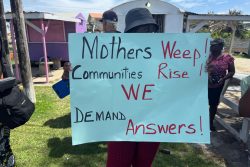Dear Editor,
Since his entrance into politics in the ’40s Cheddi Jagan had to battle against two major red herrings − communism and race. It is therefore not surprising that Mr M Maxwell’s letter in Stabroek News (February 11), ‘Cheddi Jagan was not a transformational leader’ in a rhetorical exchange with Mr Vishnu Bisram, sang a similar tune. This followed a very interesting and thought-provoking article by the well-respected Senior Counsel Mr Ralph Ramkarran, ‘The PPP’s enduring fear’ (Sunday Stabroek, January 14), where he argued that Cheddi Jagan was the first and last transformational leader in the PPP.
The caricature of Cheddi Jagan by Mr Maxwell is distorted, fabricated and utter nonsense, as race and ideology were always used against him, but this did not prevent him from being among the most respected leader in the Western hemisphere. Mr Maxwell argued that Indians supported Cheddi Jagan because of race. He further argued that “if Jagan had won the 1964 elections, Indians would have fled from Guyana under a PPP communist government.” Mr Maxwell provided no evidence to support his spurious claims. In the 1947 elections, Jagan was successful against the incumbent John D’Aguiar, H L Palmer from the League of Coloured Peoples and Frank Jacobs from British East Indian Association, all of whom used race, ideology and money during the campaign, while Jagan relied on foot soldiers like Sidney King. Moreover, Jagan always relied on political and economic analysis not race as the trial-blazer for all his election campaigning. Many more prominent Indian leaders like C R Jacobs, Daniel Debedin were unable to trounce Jagan despite open appeals to race and expounding the evils of communism. Jagan’s constituency was 75 per cent non-Indian (Nath 1950), so how could he rely on race to win in 1947?
Stephen Rabe pointed out that in 1960 British Guiana seemed was well poised, anticipating independence. Its population was growing steadily, there was a per capita income of $384, and British Guiana was better off than Central American nations and ahead of South American nations like Bolivia and Paraguay. It also had substantial foreign investment. Why Guyana failed to achieve its vision is not a complex mystery (US intervention in British Guiana).
Mr Maxwell further fictitiously argued that the multiracial PPP victory in the 1953 election winning 18 out of 24 seats represented only 51 per cent of the popular votes. What Mr Maxwell failed to point out was that the PPP only contested 22 of the seats in a first-past-the-post system under a limited system of universal voting enacted for the first time in 1953. The 51 per cent of votes could not come from only Indians as Maxwell seemed to insinuate, but 51 per cent in the circumstances was overwhelming.
Jagan’s political activism had no boundaries as Mr Maxwell would like us to believe. Clem Seecharan (2005) wrote that on May 21, 1949 the Commissioner of Labour Bessel complained that the British Guiana Workers’ League (Rose Hall Branch) had consented to Dr Jagan becoming chairman of the District Committee for the Corentyne area. Bessel noted that the Sugar Producers Association was up in arms against the idea, and had threatened to terminate relations with the League which represented mainly African factory workers, if Dr Jagan became an officer. He cautioned that although Dr Jagan’s accession to the union office would have been legitimate, because they didn’t like his politics they seemed to be in favour of only a biddable man (Sweetening Bitter Sugar). Dr Jagan was also President of the Sawmill and Forest Workers Union with a large African following in 1953. His early activism was at the water front where he met Ashton Chase and Joycelyn Hubbard from the trade union movement. Race was used as a weapon by Mr Maxwell and his cohorts to temper Dr Jagan’s struggle for the liberation of the working people of Guyana.
Jagan’s Marxist orientation was the best weapon adopted by any leader to defend the working class in the era of colonialism. Marx’s analysis of capitalism and its boom-bust cycle, the concentration and centralization of wealth and the historical development of the socio-economic system until today remains a superior theoretical analysis that cannot be disputed. His theory has been rejuvenated, especially after the global financial crisis (2009) that relegated numerous pensioners in anglo-American society to the borders of destitution. It is precisely for this reason that Clem Seecharan argued that “Dr. Jagan’s Marxist creed and his sincerity of purpose… [insulated] him against all opposition regardless how powerful.” Can Mr Maxwell argue that Jagan contemporaries in the Caribbean who openly embraced free market capitalism created a more viable economy in this the era of globalization?
Guyana benefited from Jagan’s early economic policies when he created the first industrial site at Ruimveldt that saw the burgeoning of small manufacturers like Continental Agencies and the Kissoon Group, just to name a few, as Jagan exposed them to quality production around the world and organized long-term financing from CDC to facilitate their off-take. Further, had the Tiger Hill hydro project not being blocked by the anglo-American conspiracy, manufacturing would have transformed the economic landscape of Guyana long before East Asia. Jagan also changed the Chamber of Commerce regulations in the ’50s that made it easier for other ethnic groups to participate in business, especially commerce. Dr Jagan had always from the inception argued for the role of the state and small business entrepreneurs in his economic policy.
Dr Jagan’s policies were always geared for social transformation, especially of the poor and rural population. Their access to education and health was a priority. Time and space does not permit me to go into full details on this score, but Jagan’s activism to transform Guyana with both political and economic independence is second to none. None of Mr Maxwell’s novices in the AFC leadership can lace Jagan’s shoe. True Guyana, remain racially divided through no fault of Dr Jagan but there has been well-orchestrated action to keep the country divided since the colonial period.
Dr Jagan represented all exploited races with the same zeal and passion. It is not surprising on that on May 27, 1953, Dr Jagan was charged and hauled before the courts for trespassing on the property of Magistrate Akbar Khan after he evicted his tenant Lily Parris. Dr Jagan climbed through the window so as to allow her to gain access to her room at 166 Charlotte Street in Georgetown (Chronicle 1953).
Finally, Dr Jagan’s contributions, despite Mr Maxwell’s mudslinging and his communist phobia are well recognised by top world leaders. Jean Chretien in his memoir My years as Prime Minister (2007) wrote that he struck up a warm friendship with Dr Jagan, a colourful and controversial President of Guyana whom he always found to be intelligent, articulate and good company. There are other world leaders like Bill Clinton, Jimmy Carter and Nelson Mandela who share the same view as Jean Chretien, that would render Mr Maxwell’s criticism utterly meaningless. Despite any shortcomings Dr Jagan enjoyed the greatest legitimacy among all races in Guyana. It is for this reason he could have cleared a majority in all fair and free elections in Guyana. Finally, Dr Jagan’s nationalism took precedence over any ideology.
Yours faithfully,
(Name and address provided)









